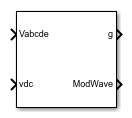PWM Generator (Five-phase, Two-level)
Libraries:
Simscape /
Electrical /
Control /
Pulse Width Modulation
Description
The PWM Generator (Five-phase, Two-level) block controls switching behavior for a five-phase, two-level power converter. The block:
Calculates on-gating and off-gating times based on the block inputs:
Five sinusoidal reference voltages, one per phase
A DC-link voltage
Uses the gating times to generate ten switch-controlling pulses.
Uses the gating times to generate modulation waveforms.
Continuous PWM
The block only provides continuous pulse width modulation (PWM). The figure shows the general difference between continuous sinusoidal pulse width modulation (SPWM) and continuous space vector modulation (SVM) waveforms.

Sampling Mode
This block allows you to choose natural, symmetric, or asymmetric sampling of the modulation wave.
The PWM Generator (Five-phase, Two-level) block does not perform carrier-based PWM. Instead, the block uses input signals to calculate gating times and then uses the gating times to generate both the switch-controlling pulses and the modulation waveforms that it outputs.
Carrier-based PWM is, however, useful for showing how the sampling mode that you select relates to the switch-on and switch-off behavior of the pulses that the block generates. A generator that uses a two-level, carrier-based PWM method:
Samples a reference wave.
Compares the sample to a triangle carrier wave.
Generates a switch-on pulse if a sample is higher than the carrier signal or a switch-off pulse if a sample is lower than the carrier wave.
To determine switch-on and switch-off pulse behavior, a two-level carrier-based PWM generator uses these methods to sample the triangle wave:
Natural — The sampling and comparison occur at the intersection points of the modulation wave and the carrier wave.

Asymmetric — Sampling occurs at the upper and lower boundaries of the carrier wave. The comparison occurs at the intersection that follows the sampling.

Symmetric — Sampling occurs at only the upper boundary of the carrier wave. The comparison occurs at the intersection that follows the sampling.

Ports
Input
Output
Parameters
Extended Capabilities
Version History
Introduced in R2021a
